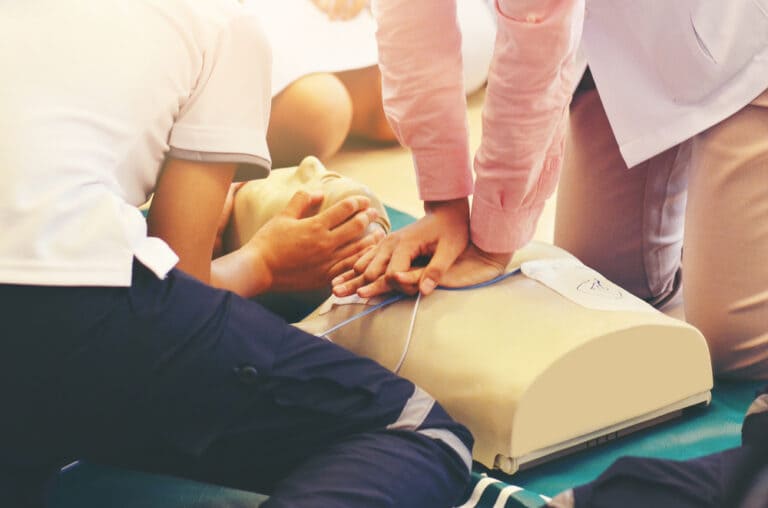One Person CPR And Two Person CPR: Differences In Technique
Imagine this scenario. You are among a group of friends shopping at a mall when suddenly a slightly older adult near you collapses to the floor with what seems like a heart attack.
Since your group is closest to the fallen person, you are all moved to help immediately. One of you checks if the person is still breathing, but he is not. Another of you checks his pulse to see if it’s beating, but it’s not. You all know CPR is desperately needed to be given to the patient. What do you do? Here’s what you need to start with.
One of you has to be designated to call the ambulance as fast as possible and be on the lookout for professional help’s arrival. Another one of you needs to keep the crowds away from the patient to provide enough ventilation and space for his safety and comfort. The most confident two in your group need to start CPR, pronto.
How do you do the two person CPR technique, and how does it differ from the basic one person CPR technique? Let’s find out.
The basic one person CPR technique
Let’s visit the basic one person CPR technique first, so we can then gauge how the two person CPR technique will be different. The steps to follow for the one person CPR technique are these:
-
- Check if the patient is in a safe place, and place the patient’s body in a face-up, stomach-up sleeping position − for access to the patient’s chest, face, nose, throat, and mouth.
- Check if the patient is breathing. If there is no breathing, it could indicate respiratory or lung failure (pulmonary arrest). Then check if a pulse is beating at the patient’s wrists and neck. There could have been a heart attack (cardiac arrest) if there is no pulse.
- Get ready to do the CPR. Kneel beside the patient and press the heel (lower part) of the palm of one hand on the patient’s chest between the nipples. Clutch the other palm over the first one. Then, bearing down with the weight and pressure of your arms and whole body, begin compressions on the patient’s chest.
- Each compression must be at least 2 inches deep, with a small release gap to let the chest rise back to position. Then the next compression-and-release should follow …and the next one … and so on.
- Keep on with the compressions at a rate of about 100-120 compressions per minute. If you hum the song “Stayin’ Alive” by the Bee Gees, your compressing frequency and rhythm will be correct.
- All this is good if the patient has no pulse but is still breathing. But if the breathing has also stopped, you need to breathe for the patient. So, the technique changes a bit.
- Give 30 compressions on the chest. Then tilt the head and chin of the patient upward to open the airway. Put your mouth over the patient’s mouth and breathe out from your lungs into the patient’s lungs.
- Make it a deep and long breath of at least a second or two. Give a small gap for the chest to rise … and breathe again. This is called rescue breathing (or mouth-to-mouth resuscitation). You need to stop after two such breaths and go back to chest compressions again.
- Follow this sequence … 30 chest compressions, head and chin tilt-up, and 2 rescue breaths … then again 30 chest compressions, head and chin tilt-up, and 2 rescue breaths … you must keep at this till medical help arrives.
- One person CPR can be tough and exhausting, but it’s critical. If at any time you let up, and there is a gap longer than 4-8 minutes, the brain can become irreparably damaged, and the patient could die due to insufficient blood going to the brain.
The basic two person CPR technique
The process for the two person CPR technique is the same, except for these changes:
-
- One of the rescuers must be positioned near the chest area while the other one is positioned near the head of the victim. This arrangement allows quick position changes.
- The person positioned near the patient’s chest must do the 30 chest compressions, while the other rescuer (positioned near the patient’s head) is in charge of the head and chin tilt-up and the two rescue breaths to be given.
- The process must go on without a break for 5 cycles (i.e., each cycle consisting of 30 chest compressions by one rescuer, with the head-and chin tilt-up, and 2 rescue breaths from the other rescuer).
- At the end of 5 cycles, the two rescuers must exchange places, and the one who was doing the breathing now should do the compressions, while the other does the rescue breaths.
4 most-asked queries on One Person CPR vs. Two Person CPR
Naturally, there has to be a great deal of coordination if the two person CPR technique has to be used.
The good side of it is that when two people help, the task feels easier, and the rescuers don’t get fatigued quickly. They can keep going on at a steady pace for a longer time till professional medical help arrives.
On the flip side, the two person CPR technique can give room for lots of confusion if the two rescuers are both amateurs and don’t have a smooth protocol to follow.
The 4 most-asked queries of two person rescue teams are below – with their answers. Reading these can help when a two person CPR routine needs to be followed without glitches.
1. What is the advantage of two person CPR over one person CPR?
According to Barbara Jackson, a CPR expert writing on the CPR Certification Online HQ site, “Two person CPR is more efficient due to one person performing compressions and another giving breaths. It’s not as tiring, and there’s less of a delay between compressions and breaths. Therefore, it’s more efficient, and it’s more effective.”
2. When doing two person CPR, which rescuer decides the frequency of compressions and sets the rhythm?
The Advanced Medical Certification Course states that when performing two person CPR, the rescuer doing the compressions must quickly review and set the tempo for the compression ratio, and the rescuer doing the breathing must follow that cue. It would help a lot if the rescuer doing the compressions counted the compressions out aloud.
3. When switching positions in a two person CPR rescue, who calls for the switch?
The Online CPR Certification website (of the American Academy of CPR & First Aid) advises that the rescuer who is not performing the compressions should immediately stand up near the head of the victim, when the two rescue breaths have been given. This allows quick position changes without any interruption in the rhythm. The person performing the CPR compressions should say “switch” when it’s the other rescuer’s turn. This gives the other rescuer the cue to get into a position to perform CPR.
4. What is the correct way to switch positions between the two rescuers?
Medcourse.in states that the first rescuer should go to the head end and the second rescuer should come for compressions. This switch should occur fast, and the two rescuers should not cross over. The rescuer at the head end should go to the free side of the patient, not to the side of the first rescuer. The maximum changeover time can be five seconds − no more than that.
In summary …
It’s always good to learn both − one person CPR and two person CPR techniques. Here’s our clarion call you too can follow: “Be CPR-aware. Save lives. Be a Heartstrong Hero.”
References:
-
- Jackson, Barbara. CPR Certification Online HQ. “Two-Person/Rescuer CPR Approach.” Accessed August 20, 2022. https://www.cprcertificationonlinehq.com/blog/two-person-cpr-method
- Advanced Medical Certification. “Two Rescuer BLS For Adults.” Accessed August 20, 2022. https://advancedmedicalcertification.com/lesson/two-rescuer-adult-bls-acls-online-handbook/
- American Academy Of CPR And First Aid, Inc. “What is a Two-Person CPR Method?.” Accessed August 20, 2022. https://www.onlinecprcertification.net/blog/what-is-a-two-person-cpr-method/
- Medcourse. “Two rescuer Adult BLS.” Accessed August 20, 2022. https://medcourse.in/lesson/two-rescuer-adult-bls/


